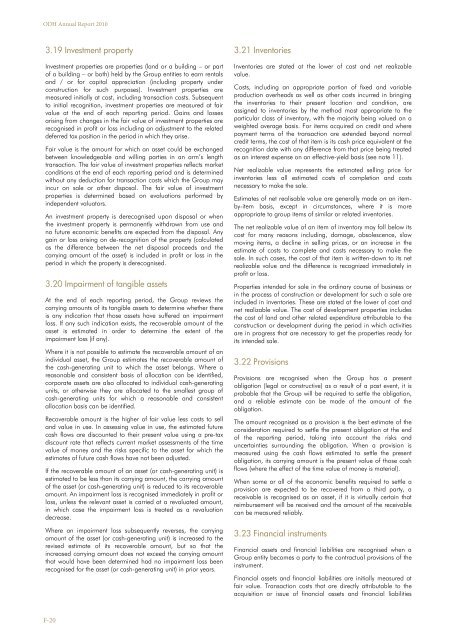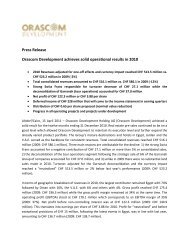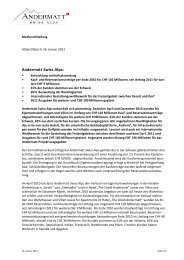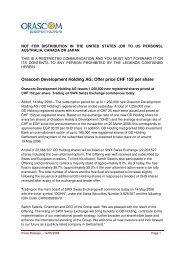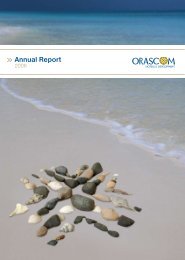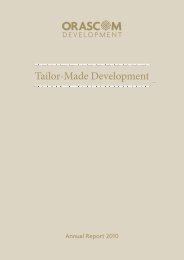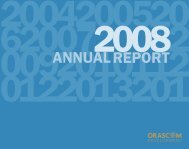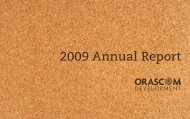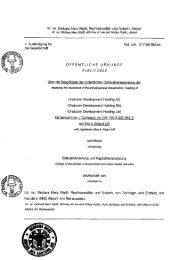FY 2010 Annual Report - Part II - Orascom Development
FY 2010 Annual Report - Part II - Orascom Development
FY 2010 Annual Report - Part II - Orascom Development
Create successful ePaper yourself
Turn your PDF publications into a flip-book with our unique Google optimized e-Paper software.
ODH <strong>Annual</strong> <strong>Report</strong> <strong>2010</strong><br />
3.19 Investment property<br />
Investment properties are properties (land or a building – or part<br />
of a building – or both) held by the Group entities to earn rentals<br />
and / or for capital appreciation (including property under<br />
construction for such purposes). Investment properties are<br />
measured initially at cost, including transaction costs. Subsequent<br />
to initial recognition, investment properties are measured at fair<br />
value at the end of each reporting period. Gains and losses<br />
arising from changes in the fair value of investment properties are<br />
recognised in profit or loss including an adjustment to the related<br />
deferred tax position in the period in which they arise.<br />
Fair value is the amount for which an asset could be exchanged<br />
between knowledgeable and willing parties in an arm’s length<br />
transaction. The fair value of investment properties reflects market<br />
conditions at the end of each reporting period and is determined<br />
without any deduction for transaction costs which the Group may<br />
incur on sale or other disposal. The fair value of investment<br />
properties is determined based on evaluations performed by<br />
independent valuators.<br />
An investment property is derecognised upon disposal or when<br />
the investment property is permanently withdrawn from use and<br />
no future economic benefits are expected from the disposal. Any<br />
gain or loss arising on de-recognition of the property (calculated<br />
as the difference between the net disposal proceeds and the<br />
carrying amount of the asset) is included in profit or loss in the<br />
period in which the property is derecognised.<br />
3.20 Impairment of tangible assets<br />
At the end of each reporting period, the Group reviews the<br />
carrying amounts of its tangible assets to determine whether there<br />
is any indication that those assets have suffered an impairment<br />
loss. If any such indication exists, the recoverable amount of the<br />
asset is estimated in order to determine the extent of the<br />
impairment loss (if any).<br />
Where it is not possible to estimate the recoverable amount of an<br />
individual asset, the Group estimates the recoverable amount of<br />
the cash-generating unit to which the asset belongs. Where a<br />
reasonable and consistent basis of allocation can be identified,<br />
corporate assets are also allocated to individual cash-generating<br />
units, or otherwise they are allocated to the smallest group of<br />
cash-generating units for which a reasonable and consistent<br />
allocation basis can be identified.<br />
Recoverable amount is the higher of fair value less costs to sell<br />
and value in use. In assessing value in use, the estimated future<br />
cash flows are discounted to their present value using a pre-tax<br />
discount rate that reflects current market assessments of the time<br />
value of money and the risks specific to the asset for which the<br />
estimates of future cash flows have not been adjusted.<br />
If the recoverable amount of an asset (or cash-generating unit) is<br />
estimated to be less than its carrying amount, the carrying amount<br />
of the asset (or cash-generating unit) is reduced to its recoverable<br />
amount. An impairment loss is recognised immediately in profit or<br />
loss, unless the relevant asset is carried at a revaluated amount,<br />
in which case the impairment loss is treated as a revaluation<br />
decrease.<br />
Where an impairment loss subsequently reverses, the carrying<br />
amount of the asset (or cash-generating unit) is increased to the<br />
revised estimate of its recoverable amount, but so that the<br />
increased carrying amount does not exceed the carrying amount<br />
that would have been determined had no impairment loss been<br />
recognised for the asset (or cash-generating unit) in prior years.<br />
3.21 Inventories<br />
Inventories are stated at the lower of cost and net realizable<br />
value.<br />
Costs, including an appropriate portion of fixed and variable<br />
production overheads as well as other costs incurred in bringing<br />
the inventories to their present location and condition, are<br />
assigned to inventories by the method most appropriate to the<br />
particular class of inventory, with the majority being valued on a<br />
weighted average basis. For items acquired on credit and where<br />
payment terms of the transaction are extended beyond normal<br />
credit terms, the cost of that item is its cash price equivalent at the<br />
recognition date with any difference from that price being treated<br />
as an interest expense on an effective-yield basis (see note 11).<br />
Net realizable value represents the estimated selling price for<br />
inventories less all estimated costs of completion and costs<br />
necessary to make the sale.<br />
Estimates of net realisable value are generally made on an itemby-item<br />
basis, except in circumstances, where it is more<br />
appropriate to group items of similar or related inventories.<br />
The net realizable value of an item of inventory may fall below its<br />
cost for many reasons including, damage, obsolescence, slow<br />
moving items, a decline in selling prices, or an increase in the<br />
estimate of costs to complete and costs necessary to make the<br />
sale. In such cases, the cost of that item is written-down to its net<br />
realizable value and the difference is recognized immediately in<br />
profit or loss.<br />
Properties intended for sale in the ordinary course of business or<br />
in the process of construction or development for such a sale are<br />
included in inventories. These are stated at the lower of cost and<br />
net realizable value. The cost of development properties includes<br />
the cost of land and other related expenditure attributable to the<br />
construction or development during the period in which activities<br />
are in progress that are necessary to get the properties ready for<br />
its intended sale.<br />
3.22 Provisions<br />
Provisions are recognised when the Group has a present<br />
obligation (legal or constructive) as a result of a past event, it is<br />
probable that the Group will be required to settle the obligation,<br />
and a reliable estimate can be made of the amount of the<br />
obligation.<br />
The amount recognised as a provision is the best estimate of the<br />
consideration required to settle the present obligation at the end<br />
of the reporting period, taking into account the risks and<br />
uncertainties surrounding the obligation. When a provision is<br />
measured using the cash flows estimated to settle the present<br />
obligation, its carrying amount is the present value of those cash<br />
flows (where the effect of the time value of money is material).<br />
When some or all of the economic benefits required to settle a<br />
provision are expected to be recovered from a third party, a<br />
receivable is recognised as an asset, if it is virtually certain that<br />
reimbursement will be received and the amount of the receivable<br />
can be measured reliably.<br />
3.23 Financial instruments<br />
Financial assets and financial liabilities are recognised when a<br />
Group entity becomes a party to the contractual provisions of the<br />
instrument.<br />
Financial assets and financial liabilities are initially measured at<br />
fair value. Transaction costs that are directly attributable to the<br />
acquisition or issue of financial assets and financial liabilities<br />
F-20


